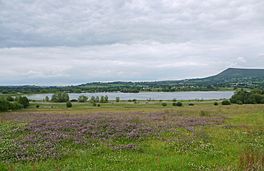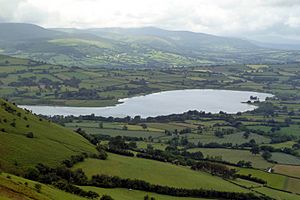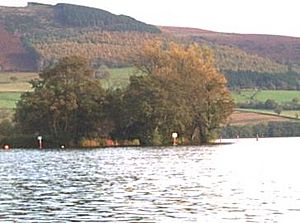Llangorse Lake facts for kids
Quick facts for kids Llangorse Lake |
|
|---|---|

The lake viewed from the southwest
|
|
| Location | Wales |
| Coordinates | 51°55′51.46″N 3°15′45.92″W / 51.9309611°N 3.2627556°W |
| Lake type | eutrophic glacial natural |
| Basin countries | United Kingdom |
| Surface area | 1.53 km2 (0.59 sq mi) |
| Surface elevation | 154 m (505 ft) |
Llangorse Lake (Welsh: Llyn Syfaddon, also called Llyn Syfaddan) is the biggest natural lake in Mid and South Wales. You can find it in the Brecon Beacons National Park, close to the town of Brecon and the village of Llangors.
This lake is famous for its great coarse fishing (especially for pike), exciting watersports, and even a legendary monster called the afanc (nicknamed 'Gorsey'). It also has the only example of a crannog (an old artificial island) in all of Wales! Llangorse Lake is mentioned a lot in old Welsh folklore stories. It's also a very important place for nature conservation around the world.
Because people have lived and been active around the lake for a very long time, it has had many different names. Some of its older Welsh names include Llyn Syfaddon or Llyn Syfaddan. The name Llangorse Lake is actually quite new.
Contents
About Llangorse Lake's Geography
Llangorse Lake is a glacial lake that is rich in nutrients, meaning it has lots of plant life. It has a perimeter of about 3 miles (5 km) and covers an area of 327 acres (1.32 km2). The lake is about 1-mile (1.6 km) long and sits 505 feet (154 m) above sea level. Its deepest point is 7.5 meters.
The lake formed in a basin carved out by glaciers, with some extra help from rocky debris left behind by the ice. It's part of the River Wye's water system, but it's also very close to the River Usk to the south. The Afon Llynfi is the main river that flows into the lake. It then continues as the stream that carries water out of the lake.
Amazing Nature and Wildlife
Llangorse Lake is a special place for nature. It's called a Site of Special Scientific Interest (SSSI) and a Special Area of Conservation. This means it's protected because it has many fish and birds, often in large numbers. Back in the 12th century, a writer named Gerald of Wales even wrote about how many waterfowl (birds that live on water) he saw there. It's a great example of a natural lake full of important water plants.
People have told stories about huge pike caught in Llangorse Lake. One story from 1846 claims a pike weighing 68 pounds (31 kg) was caught, which would have been the biggest in the world! However, this story isn't proven. The biggest pike actually caught in the UK weighed 46 pounds (21 kg). More recently, in 2004, a very large pike skull was found on the lake's shore. It was so big that the Environment Agency took it to find out how old the fish was.
The Llangasty Nature Reserve is an important protected area around the lake. The lake is also home to the rare Scarce Blue-tailed Damselfly. In May 2011, hundreds of water voles were released near the lake. This was part of a project to help bring their numbers back up.
History of Llangorse Lake
The Ancient Crannog Island
The crannog is a small, human-made island located about 40 metres (130 ft) from the north shore of the lake. It was built using huge oak planks, with a living platform made from layers of stone, soil, and brushwood.
Archaeologists from the National Museum of Wales studied the crannog between 1989 and 1993. They found interesting things like a high-quality piece of cloth and a bronze hinge from a special box called a reliquary. This hinge was decorated in a style similar to art found in Ireland from the 8th or 9th century. The TV show Time Team even joined the dig in 1993, and it was shown in their first season in 1994. In 2005, work was done to protect the island from being worn away by the water.
The Old Dugout Boat
In 1925, archaeologists found a nearly complete dugout boat in the lake. Scientists used Radiocarbon dating to figure out its age. They discovered it was from the 9th century, making it over 1,100 years old!
The Royal Fort and a Battle
In the year 916, Æthelflæd, who was a powerful leader of the Mercians, sent an army to the area of Brycheiniog. She wanted to get revenge for the killing of a Mercian abbot (a type of religious leader) and his friends. The Mercian army attacked and burned a royal fort that was located on Llangorse Lake. They also captured the Queen of Brycheiniog and 33 other people.
Gorsey: The Lake Monster of Llangorse Lake
The earliest known story about the afanc, or lake monster, of Llangorse Lake comes from a poem. It was written by a Welsh poet named Lewys Glyn Cothi in the 15th century. Here's a part of the poem:
|
|
The afanc monster was likely a very well-known part of local stories and legends when this poem was written.
Oll Lewis, a scientist who studies animals and mysterious creatures, has been looking into the Afanc of Llangorse Lake for several years. He thinks that sightings of the monster might actually be people seeing the unusually large pike that live in the lake. Another expert, Adrian Lloyd Jones, believes that afanc stories in Wales are old memories of a time when beavers lived there. Interestingly, the modern Welsh word for beaver is also afanc!




